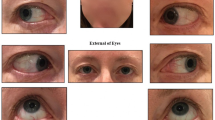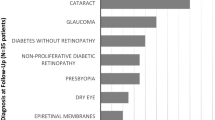Abstract
Objectives
To evaluate the accuracy of tele-ophthalmic examination (TOE) for common ocular conditions in comparison with the gold-standard in-person examination (IPE) for diagnosis and treatment advice.
Methods
In a prospective, diagnostic accuracy validation study, we recruited 339 consecutive new patients, aged ≥16 years, visiting a vision centre (VC) associated with Aravind Eye Hospital in south India during January and February, 2020. All participants underwent the TOE, followed by IPE on the same visit. The in-person ophthalmologist was masked to the TOE diagnosis and treatment advice. Data were analysed via the sensitivity specificity of TOE versus the gold-standard IPE.
Results
TOE achieved high sensitivity and specificity for identifying normal eyes with 87.4% and 93.5%, respectively. TOE had high sensitivity for cataracts (91.7%), infective conjunctivitis (72.2%), and moderate sensitivity for pterygium (62.5%), DR (57.1%), non-serious injury (41.7%), but low sensitivity for glaucoma (12.5%). TOE had high specificity ranging from 93.5% to 99.8% for all diagnoses. The sensitivity for treatment advice ranged from 58.1% to 77.2% and specificity from 96.9% to 100%.
Conclusions
The TOE in VCs has acceptable accuracy to an IPE by an ophthalmologist for correctly identifying and treating major eye ailments. Through providing universal eye care to rural populations, this model may contribute to work toward achieving Universal Health Coverage, which is a linchpin of the health-related U.N. Sustainable Development Goals (SDG).
This is a preview of subscription content, access via your institution
Access options
Subscribe to this journal
Receive 18 print issues and online access
$259.00 per year
only $14.39 per issue
Buy this article
- Purchase on Springer Link
- Instant access to full article PDF
Prices may be subject to local taxes which are calculated during checkout


Similar content being viewed by others
Data availability
The dataset is available upon request.
References
Bourne R, Steinmetz JD, Flaxman S, Briant PS, Taylor HR, Resnikoff S, et al. Trends in prevalence of blindness and distance and near vision impairment over 30 years: an analysis for the Global Burden of Disease Study. Lancet Glob Heal. 2020;9:e130–e143. https://doi.org/10.1016/S2214-109X(20)30425-3.
World Health Organization.World report on vision.; 2019. https://www.who.int/publications/i/item/world-report-on-vision.
Murthy GV, Gupta SK, Bachani D, Tewari HK, John N. Human resources and infrastructure for eye care in India: current status. Natl Med J India. 2004;17:128–34. https://pubmed.ncbi.nlm.nih.gov/15253398/.
Joseph S, Ravilla T, Bassett K. Gender Issues in a Cataract Surgical Population in South India. Ophthalmic Epidemiol. 2013;20:96–101. https://www.tandfonline.com/doi/abs/10.3109/09286586.2013.766756.
Burton MJ, Ramke J, Marques AP, Bourne RRA, Congdon N, Jones I, et al. The Lancet Global Health Commission on Global Eye Health: vision beyond 2020. Lancet Glob Heal 2021;9:e489–e551. https://doi.org/10.1016/S2214-109X(20)30488-5.
Reddy PA, Congdon N, MacKenzie G, Gogate P, Wen Q, Jan C, et al. Effect of providing near glasses on productivity among rural Indian tea workers with presbyopia (PROSPER): a randomised trial. Lancet Glob Heal. 2018;6:e1019–e1027.
Bourne RRA, Steinmetz JD, Saylan M, Mersha AM, Weldemariam AH, Wondmeneh TG, et al. Causes of blindness and vision impairment in 2020 and trends over 30 years, and prevalence of avoidable blindness in relation to VISION 2020: The Right to Sight: An analysis for the Global Burden of Disease Study. Lancet Glob Heal. 2021;9:e144–e160.
Anon. Transforming our World: The 2030 Agenda for Sustainable Development .:. Sustainable Development Knowledge Platform. https://sustainabledevelopment.un.org/post2015/transformingourworld/publication.
Anon. Vision for Everyone: accelerating action to achieve the SustainableDevelopment Goals. https://www.undocs.org/en/A/75/L.108. Accessed 10 Jan 2022.
Caffery LJ, Taylor M, Gole G, Smith AC. Models of care in tele-ophthalmology: A scoping review. J. Telemed. Telecare. 2019;25:106-22. https://pubmed.ncbi.nlm.nih.gov/29165005/.
Khanna R, Sabherwal S, Sil A, Gowth M, Dole K, Kuyyadiyil S, et al. Primary eye care in India-The vision center model. Indian J Ophthalmol. 2020;68:333–9.
Qureshi BM, Mansur R, Al-Rajhi A, Lansingh V, Eckert K, Hassan K, et al. Best practice eye care models. Indian J Ophthalmol. 2012;60:351–7.
Naidoo K, Ravilla D. Delivering refractive error services: Primary eye care centres and outreach. Community Eye Heal J. 2007;20:42–44.
Anon. Telehealth in Rural Communities | CDC. https://www.cdc.gov/chronicdisease/resources/publications/factsheets/telehealth-in-rural-communities.htm. Accessed 15 Dec 2022.
Fijalkowski N, Zheng LL, Henderson MT, Wang SK, Wallenstein MB, Leng T, et al. Stanford University Network for Diagnosis of Retinopathy of Prematurity (SUNDROP): five years of screening with telemedicine. Ophthalmic Surg Lasers Imaging Retin. 2014;45:106–13. http://journals.healio.com/doi/10.3928/23258160-20140122-01.
Bossuyt PM, Reitsma JB, Bruns DE, Gatsonis CA, Glasziou PP, Irwig L, et al. STARD 2015: An updated list of essential items for reporting diagnostic accuracy studies. BMJ. 2015;351. https://www.bmj.com/content/351/bmj.h5527. Accessed 16 Sep 2020.
Anon. Marratech video conferencing software. http://www.marratech.com/. Accessed 20 Mar 2021.
Maa AY, Medert CM, Lu X, Janjua R, Howell AV, Hunt KJ, et al. Diagnostic Accuracy of Technology-based Eye Care Services The Technology-based Eye Care Services Compare Trial Part I. Ophthalmology. 2020;127:38–44. https://doi.org/10.1016/j.ophtha.2019.07.026.
Conlin PR, Asefzadeh B, Pasquale LR, Selvin G, Lamkin R, Cavallerano AA. Accuracy of a technology assisted eye exam in evaluation of referable diabetic retinopathy and concomitant ocular diseases. Br J Ophthalmol. 2015;99:1622–7. https://bjo.bmj.com/content/99/12/1622.
Gupta SC, Kumar Sinha S, Dagar AB. Evaluation of the effectiveness of diagnostic & management decision by teleophthalmology using indigenous equipment in comparison with in-clinic assessment of patients. Indian J Med Res. 2013;138:531–5. https://www.ijmr.org.in/article.asp?issn=0971-5916;year=2013;volume=138;issue=4;spage=531;epage=535;aulast=Gupta.
Kumar S, Yogesan K. Telemedical diagnosis of anterior segment eye diseases: validation of digital slit-lamp still images. Eye. 2009;23:652–60. www.nature.com/eye.
Marmamula S, Khanna RC, Shekhar K, Rao GN. Outcomes of cataract surgery in urban and rural population in the South Indian state of Andhra Pradesh: Rapid Assessment of Visual Impairment (RAVI) project. PLoS One. 2016;11:167708. https://europepmc.org/articles/PMC5137898.
Mailu EW, Virendrakumar B, Bechange S, Jolley E, Schmidt E. Factors associated with the uptake of cataract surgery and interventions to improve uptake in low- and middle-income countries: A systematic review Wilkinson J (ed). PLoS One. 2020;15:e0235699. https://doi.org/10.1371/journal.pone.0235699.
Anon. AuroMap - Aravind Vision Centres Map. http://www.auromap.org/map.php?pid=755. Accessed 11 Jan 2022.
Anon. Annual Activity Reports of Aravind Eye Care System 2019-20. https://uat.aravind.org/annual-report/ Accessed 11 Jan 2022.
Vashist P, Senjam S, Gupta V, Manna S, Agrawal S, Gupta N, et al. Community eye-health and vision center guidelines during COVID-19 pandemic in India. Indian J Ophthalmol. 2020;68:1306–11. https://pubmed.ncbi.nlm.nih.gov/32587155/.
Acknowledgements
The authors acknowledge the cooperation and support from the staff and management of Aravind Eye Hospital, Madurai, India during the study.
Funding
This study was internally funded by the Aravind Eye Care System, India and all the study staff were full-time employees of the organization. JRE was supported by an unrestricted grant from Research to Prevent Blindness to the University of Michigan Department of Ophthalmology and Visual Sciences.
Author information
Authors and Affiliations
Contributions
SJ was responsible for designing the study, overseeing the development and implementation of the protocol, creating forms, data collection data analysis and preparation of the manuscript. VK supervised the database development and data collection and contributed to the literature search, development of protocol and manuscript preparation. MSU performed the statistical analyses and contributed to manuscript preparation DK contributed to the protocol development, performed the clinical examinations and oversaw data collection. DR contributed to the conception, design and protocol development. AMG provided logistics and administrative support and contributed to the implementation of the protocol. AK contributed to the protocol development and interpretation of results. JE provided inputs for data analysis and data interpretation and critically revised the manuscript for important intellectual content. TR was involved in the conception, design, data interpretation and overall supervision. All authors gave final approval of the version of the manuscript to be published and agreed to be accountable for all aspects of the work. SJ and TR are guarantors.
Corresponding author
Ethics declarations
Competing interests
The authors declare no competing interests.
Additional information
Publisher’s note Springer Nature remains neutral with regard to jurisdictional claims in published maps and institutional affiliations.
Rights and permissions
Springer Nature or its licensor (e.g. a society or other partner) holds exclusive rights to this article under a publishing agreement with the author(s) or other rightsholder(s); author self-archiving of the accepted manuscript version of this article is solely governed by the terms of such publishing agreement and applicable law.
About this article
Cite this article
Joseph, S., Rajendran, V.K., Khetwani, D. et al. Evaluation of a telemedicine-enabled universal eye health delivery model in rural southern India. Eye 38, 1202–1207 (2024). https://doi.org/10.1038/s41433-023-02871-8
Received:
Revised:
Accepted:
Published:
Issue Date:
DOI: https://doi.org/10.1038/s41433-023-02871-8



